Pondless waterfalls offer the perfect solution for homeowners who want the beauty and tranquility of flowing water without the maintenance challenges of traditional ponds. These innovative water features create stunning focal points while providing the soothing sounds of cascading water, all while keeping safety concerns at bay. Unlike conventional pond systems, pondless waterfalls use hidden underground reservoirs that recirculate water through pumps, making them ideal for families with children or pets. The water disappears into a bed of rocks and gravel, creating a magical effect that enhances any landscape design. These features work beautifully in small spaces, require minimal upkeep, and can be customized to fit various architectural styles from rustic natural settings to sleek contemporary designs. Whether you have a compact patio or expansive backyard, pondless waterfalls adapt to your space while adding significant value to your property and creating a peaceful retreat right outside your door.
1. Natural Rock Cascade Waterfall
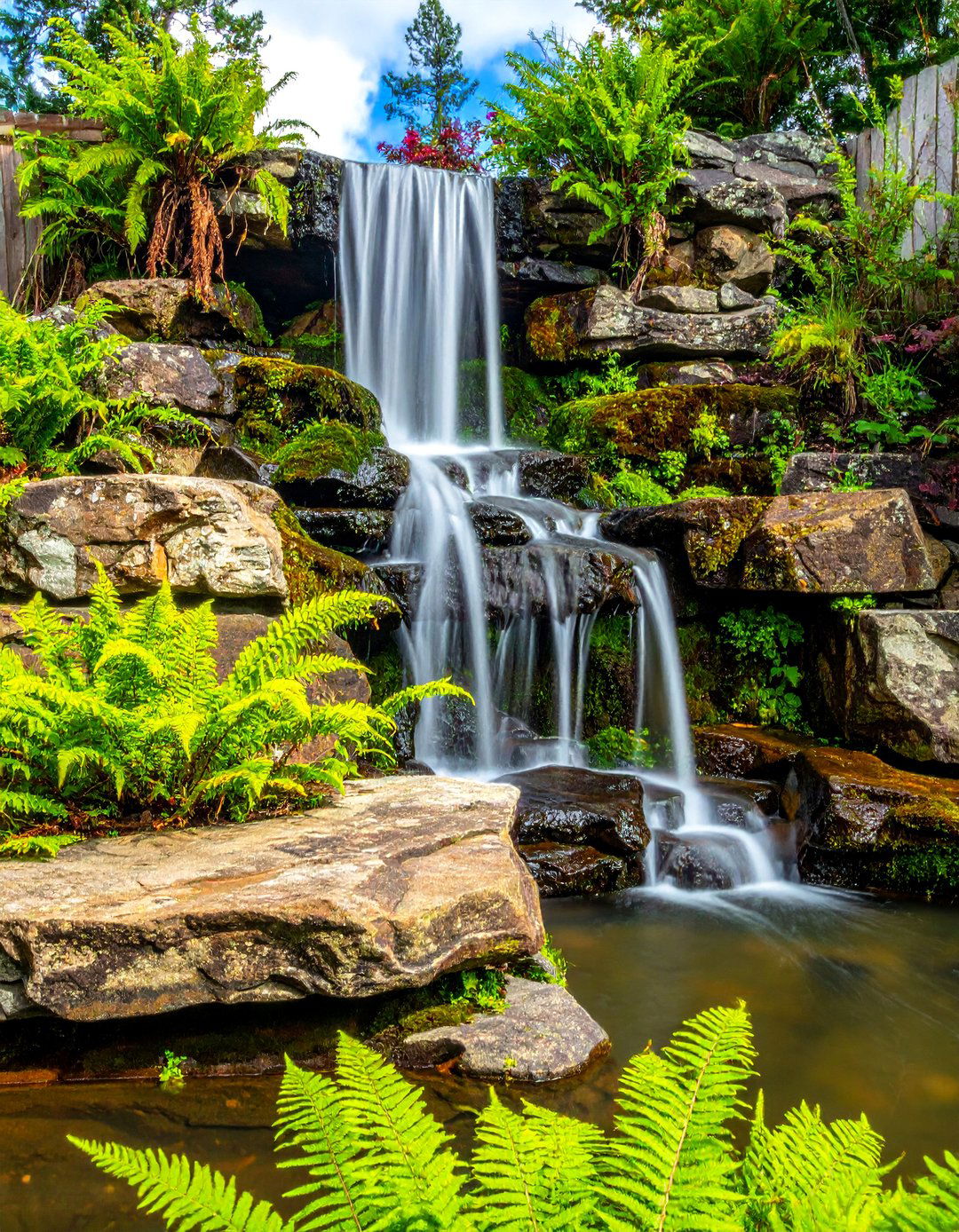
What could be more captivating than the authentic look of water flowing over weathered stone formations? Natural rock cascade waterfalls use indigenous stones stacked in layers to create multiple tiers where water gently tumbles from one level to the next. The key lies in selecting rocks that complement your local landscape while creating natural-looking ledges and crevices for water to flow through. Flat pieces of slate or limestone work perfectly for creating spillways, while rounded boulders add visual weight and stability to the structure. The organic arrangement mimics mountain streams, with water finding its natural path through the rock formation. Strategic placement of plants like ferns and mosses between rocks enhances the natural appearance, while the sound of water cascading over stone creates an incredibly peaceful atmosphere. This design works particularly well on slopes or hillsides where gravity assists the water flow, creating an authentic mountain waterfall experience in your own backyard.
2. Contemporary Linear Waterfall
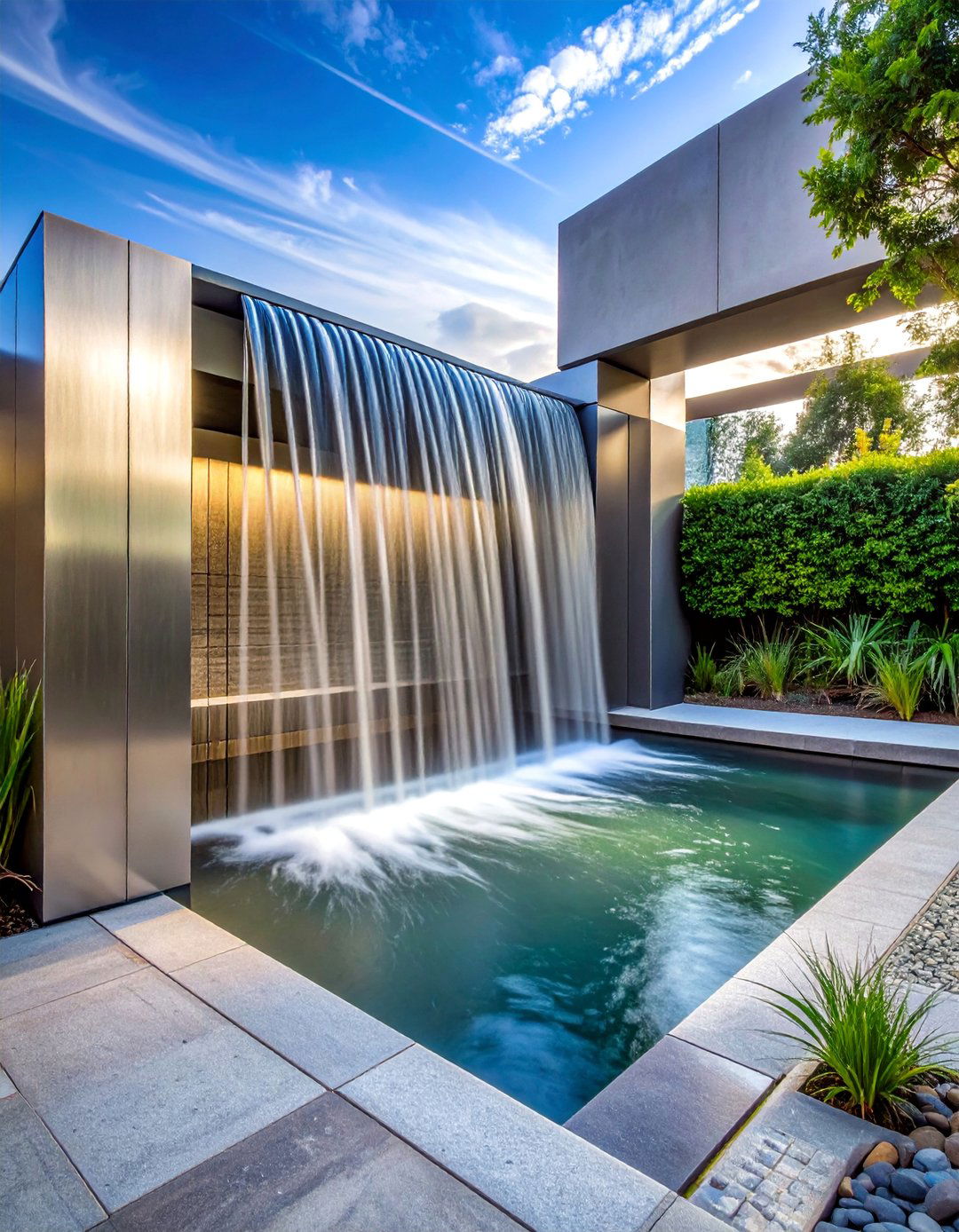
Can modern design principles transform traditional water features into architectural statements? Contemporary linear waterfalls feature clean geometric lines with water flowing in controlled sheets over sleek surfaces like stainless steel, concrete, or cut stone. These designs emphasize simplicity and precision, with water falling in uniform patterns that complement modern architecture. The spillway typically consists of a long horizontal edge, creating a dramatic wall of water that serves as both a visual and auditory focal point. Materials like brushed aluminum or dark granite provide sophisticated backdrops, while integrated LED lighting enhances the contemporary aesthetic during evening hours. The reservoir area uses angular stones or metal grating instead of natural rock piles, maintaining the structured appearance throughout the design. This style works exceptionally well in urban settings or modern homes where the waterfall becomes an extension of the architectural language, creating seamless transitions between indoor and outdoor living spaces.
3. Multi-Tier Boulder Waterfall
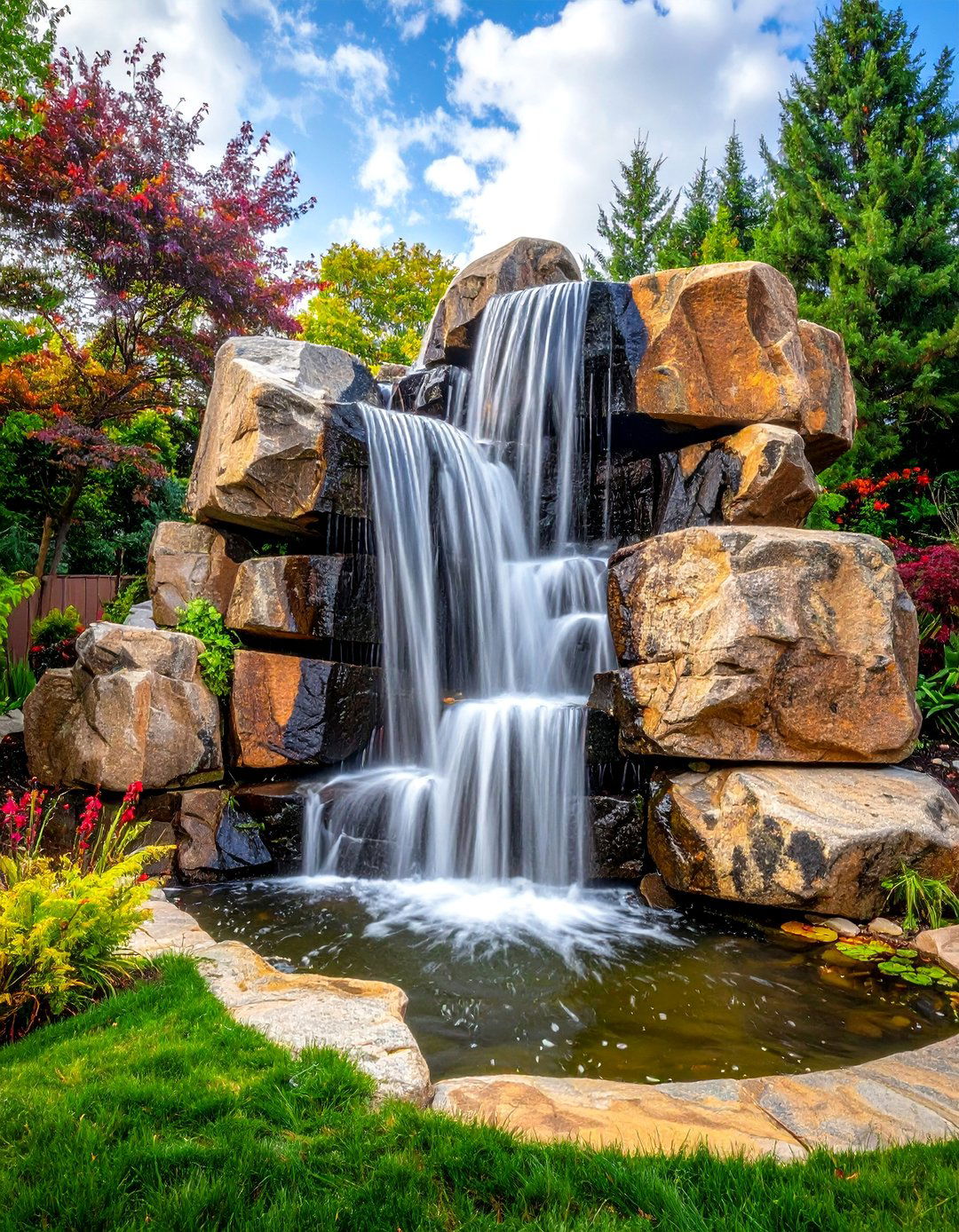
How can massive stone formations create dramatic vertical interest in compact spaces? Multi-tier boulder waterfalls use large, carefully positioned stones to create multiple falling levels that maximize visual impact within limited square footage. Each boulder is strategically placed to create natural basins where water collects before spilling to the next level below. The design relies on varying boulder sizes and shapes to create interesting water patterns and sounds as the flow changes direction and speed through different sections. Native plants and smaller accent stones fill gaps between major boulders, softening the overall appearance while maintaining the feature's bold character. The underground reservoir system handles the increased water volume from multiple spillways, while hidden lighting can highlight specific boulder formations for nighttime drama. This design works particularly well against retaining walls or in corner locations where the vertical stacking creates maximum impact without requiring extensive horizontal space, making it perfect for suburban backyards or commercial landscapes.
4. Wooden Spillway Waterfall
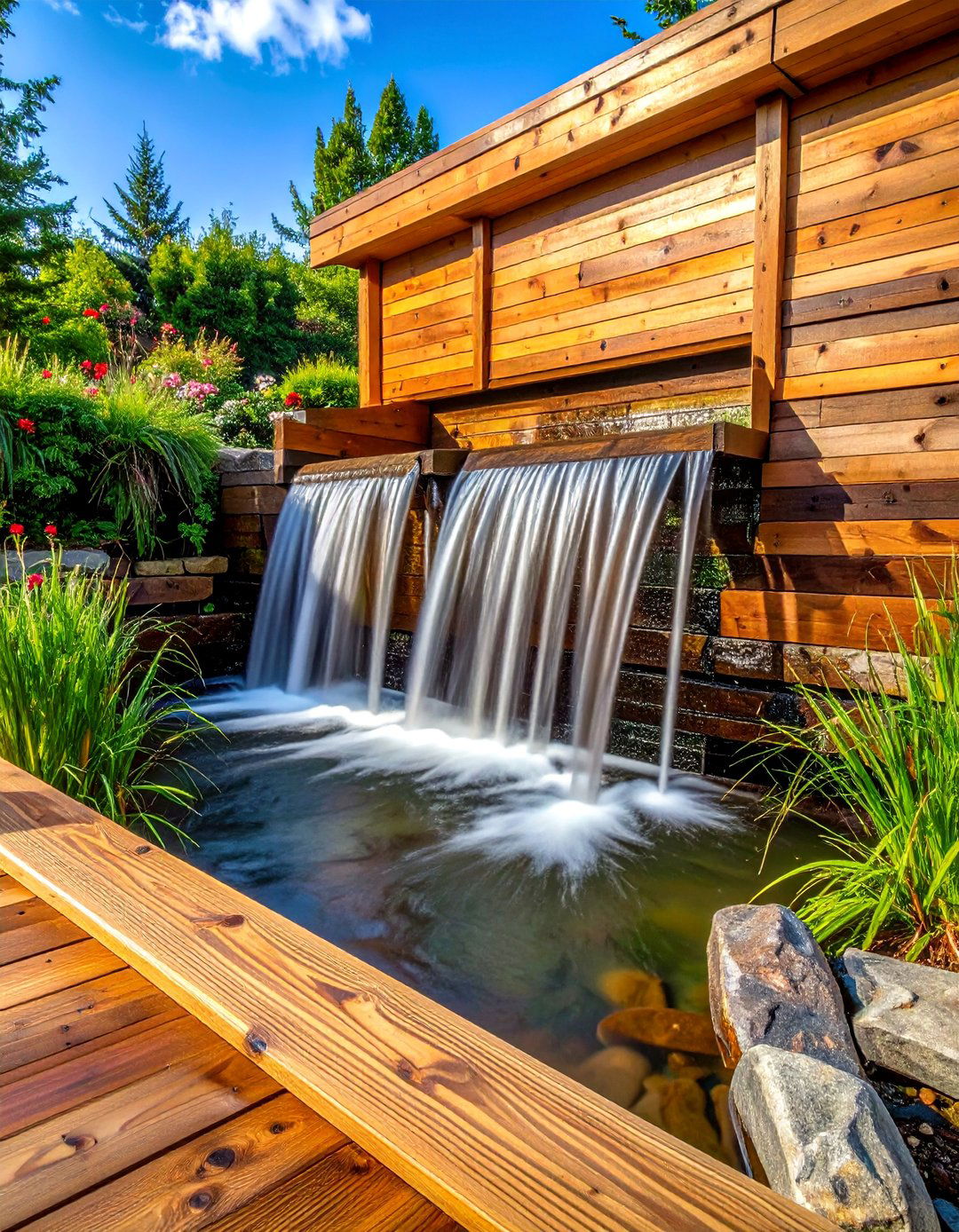
What happens when natural timber meets flowing water in outdoor design? Wooden spillway waterfalls combine the warmth of natural wood with the tranquility of cascading water, creating inviting features perfect for garden settings. Weather-resistant woods like cedar or treated lumber form horizontal spillways that direct water in controlled streams into decorative basins below. The wood can be left natural to weather into attractive gray tones, or treated with stains to match existing outdoor structures like decks or pergolas. Water flows through carefully cut notches or over smooth edges, creating gentle sounds that complement the organic nature of wood materials. Surrounding plantings often include woodland species that thrive in moist conditions, while the wooden elements provide natural perches for decorative objects or seasonal displays. The underground reservoir typically uses natural stone or decorative gravel that harmonizes with the rustic wooden elements. This design appeals to homeowners seeking features that blend seamlessly with existing garden structures while maintaining an approachable, comfortable atmosphere.
5. Retaining Wall Waterfall Integration
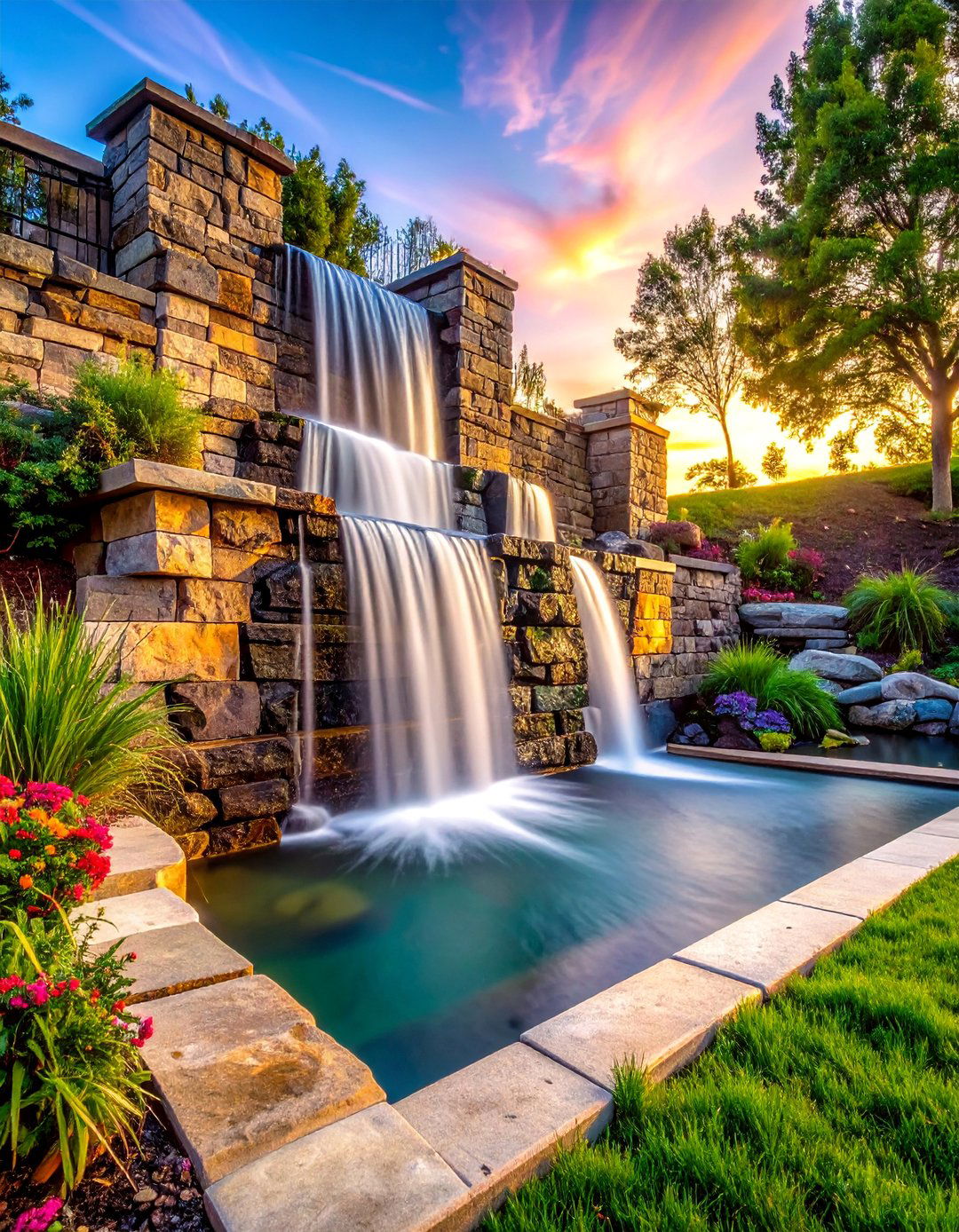
Could your existing retaining wall become the foundation for a stunning water feature? Retaining wall waterfall integrations transform functional landscape structures into beautiful focal points by incorporating water elements directly into the wall design. Water flows down the face of the wall through carefully planned channels or over integrated spillways, creating dramatic vertical displays without requiring additional ground space. The wall itself can be constructed from stacked stone, concrete blocks, or brick, with water features planned during the initial construction phase for optimal integration. Strategic placement of lights behind or beneath the water flow creates stunning nighttime displays that highlight both the water movement and wall texture. Plants can be incorporated into wall pockets or planters that benefit from the moisture created by the flowing water. The pondless reservoir system fits neatly at the base of the wall, often incorporating the same materials used in the wall construction for visual continuity throughout the design, maximizing both function and beauty.
6. Decorative Urn Waterfall Collection
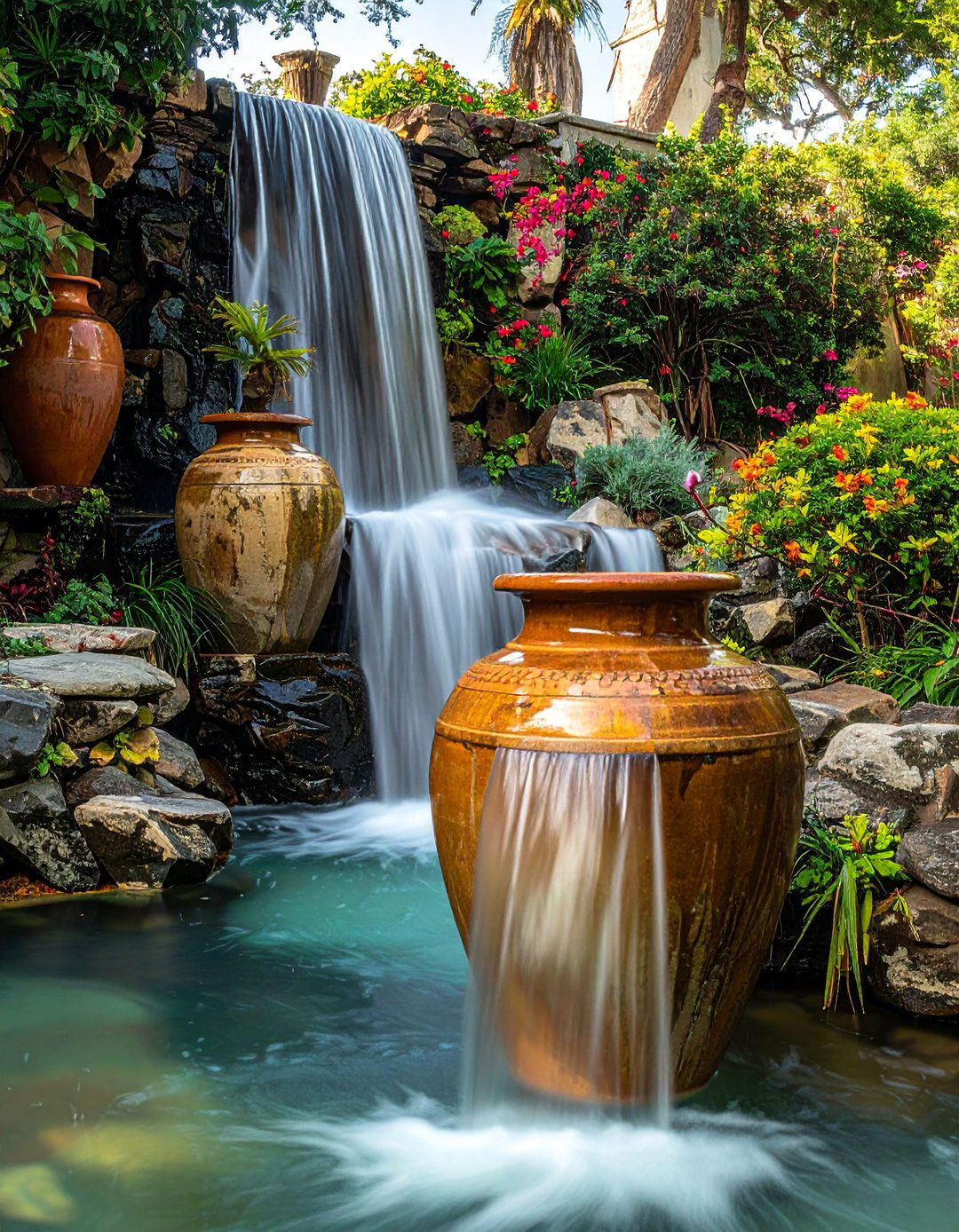
Why settle for one water source when multiple vessels can create symphony of flowing sounds? Decorative urn waterfall collections feature several large ceramic, stone, or metal vessels positioned at different heights to create a cascading water display. Each urn overflows into the next, creating multiple streams and splash points that enhance both visual interest and acoustic variety. The containers can match for formal symmetry or vary in size, color, and texture for more eclectic appearances that reflect personal style preferences. Materials range from classical stone urns reminiscent of European gardens to contemporary metal vessels that complement modern outdoor spaces. The water flow can be adjusted to create gentle overflows or more dramatic spillages depending on the desired atmosphere. Surrounding plantings often include container gardens that echo the urn theme while providing seasonal color and texture changes. The underground reservoir easily accommodates the water volume from multiple vessels, while hidden pumps ensure consistent flow to each level of the display, creating an elegant focal point.
7. Granite Boulder Stream Design
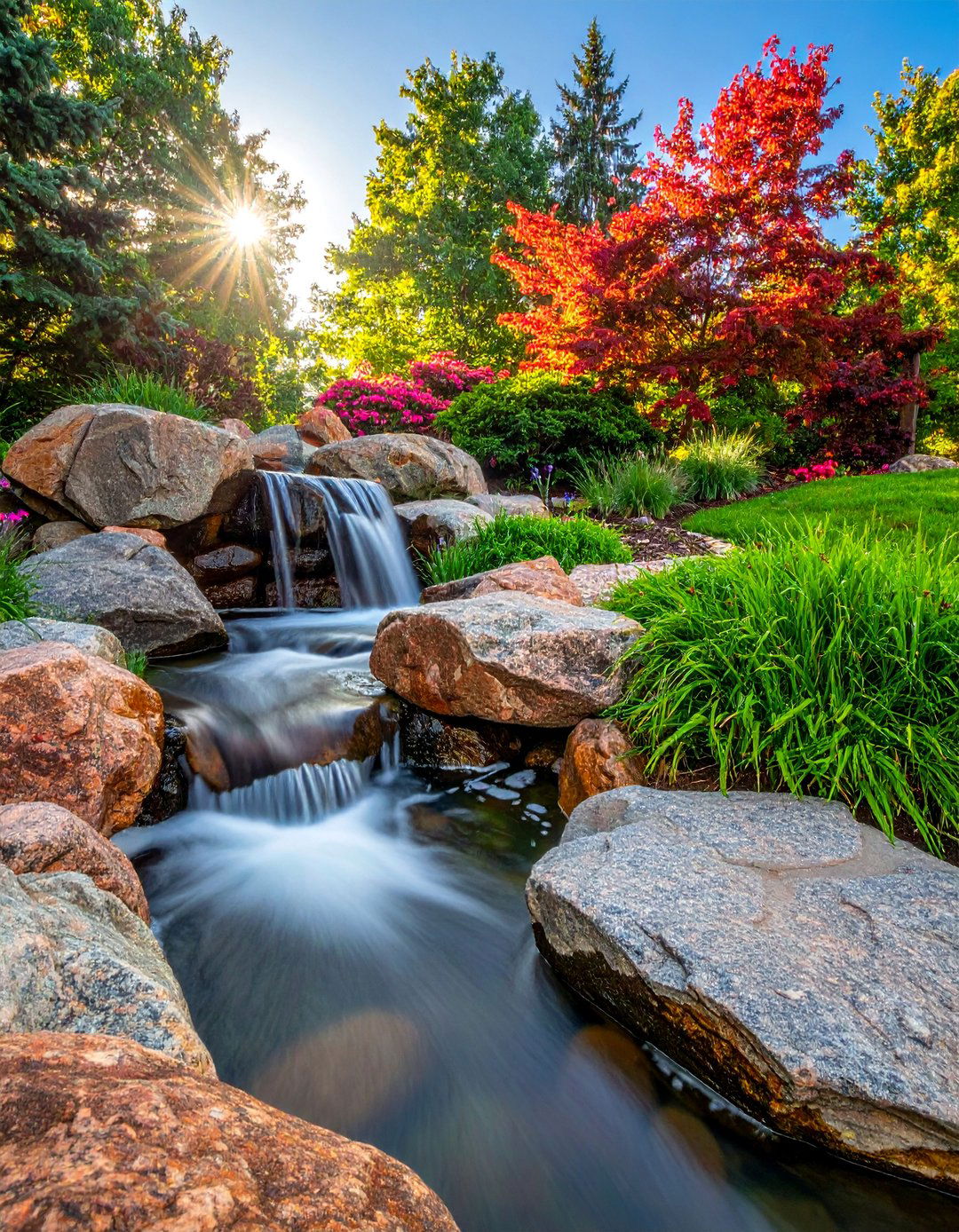
What natural elements create the most authentic creek-like experiences in residential settings? Granite boulder stream designs use massive granite stones to create winding water channels that mimic natural stream beds found in mountainous regions. The heavy, durable stones are positioned to create natural-looking meanders where water flows around and between obstacles, creating varied speeds and sounds throughout the feature. Each boulder placement is carefully planned to direct water flow while creating interesting visual compositions that look as though they formed naturally over time. The granite's natural variations in color and texture add depth and authenticity to the design, while the stone's durability ensures the feature will weather beautifully over many years. Native plants and smaller accent stones fill spaces between major boulders, creating habitat areas that attract birds and beneficial insects. The stream can incorporate multiple small pools and eddies where water temporarily collects before continuing downstream, adding complexity and interest to both the visual and auditory experience of the feature.
8. Stacked Slate Waterfall Design
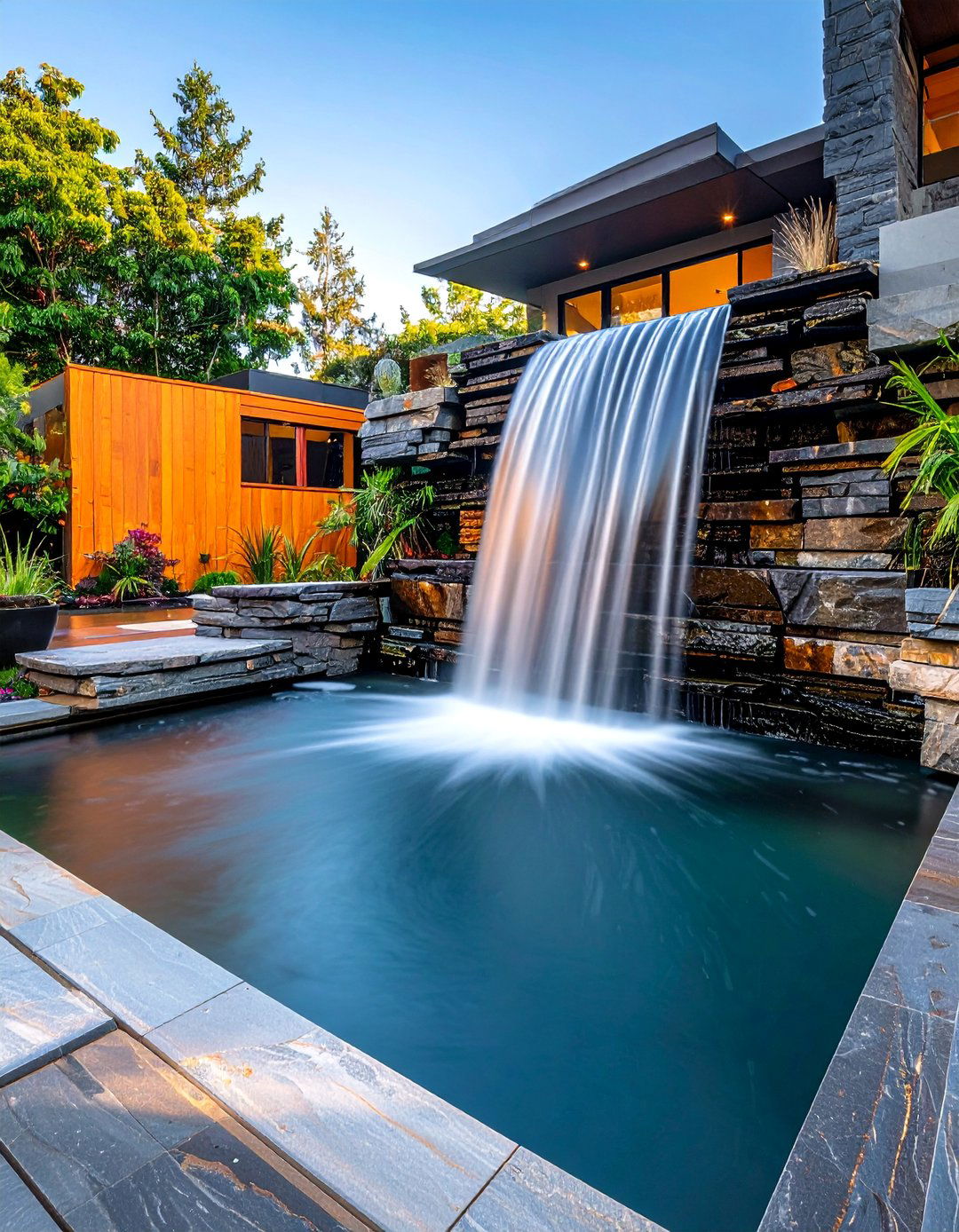
How can flat stone materials create sophisticated water displays with minimal space requirements? Stacked slate waterfall designs use carefully selected pieces of flat stone arranged in overlapping layers to create elegant cascading water features. Each slate piece is positioned to direct water flow while creating interesting shadows and textures as water flows over the smooth stone surfaces. The natural variations in slate color from gray to blue to purple create subtle color changes throughout the feature, while the flat surfaces allow for precise water control and consistent flow patterns. Gaps between slate layers can accommodate small plants or moss growth that enhances the natural appearance over time. The vertical stacking approach requires minimal ground space while creating significant visual impact, making it ideal for narrow areas or urban settings. Integrated lighting beneath or behind slate layers creates dramatic nighttime effects as light filters through the flowing water. The clean lines and sophisticated appearance of slate make this design particularly suitable for contemporary homes or formal garden settings where precision and elegance are valued.
9. Fire and Water Feature Combination
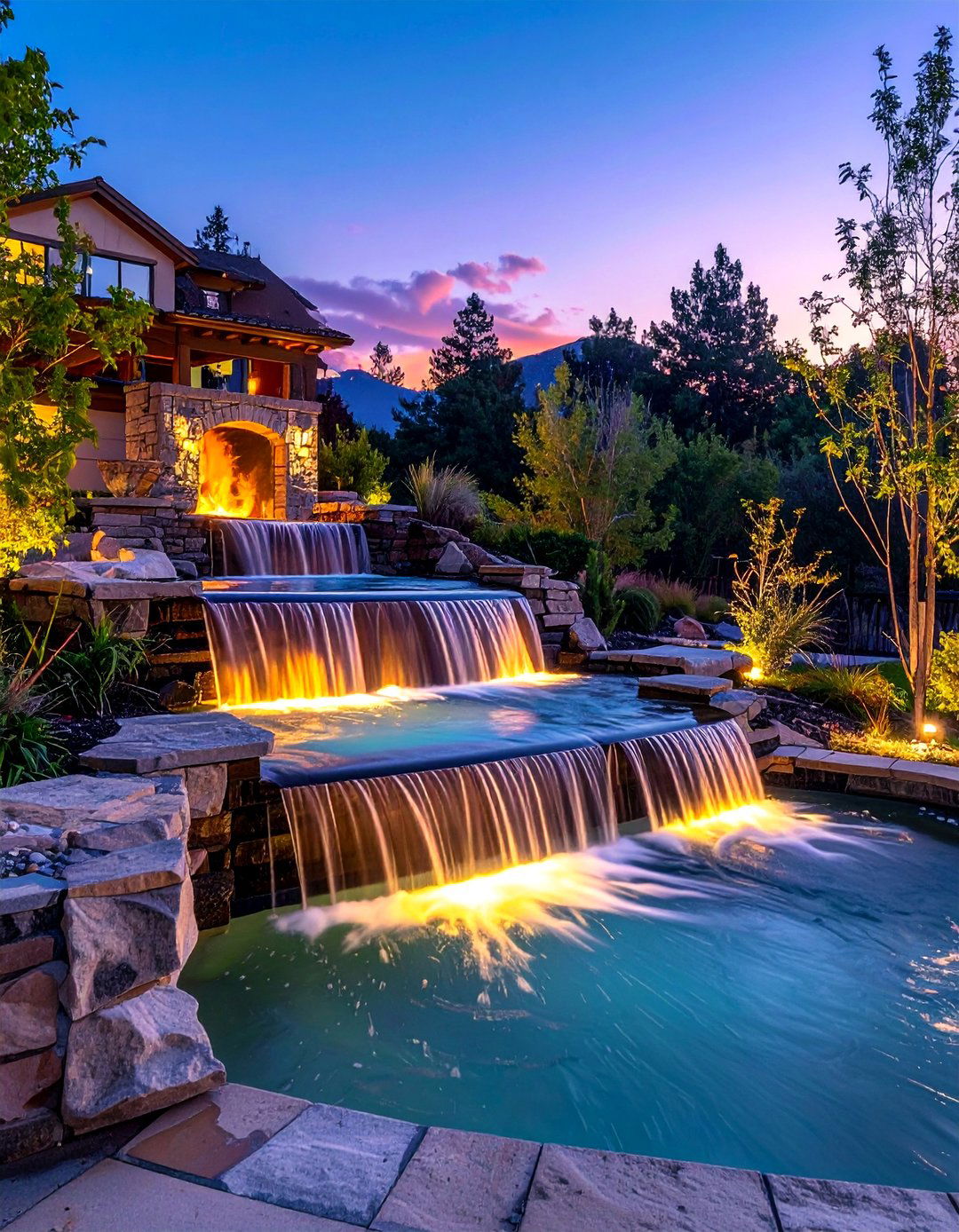
Could combining opposite elements create the ultimate outdoor focal point? Fire and water feature combinations integrate flame elements with cascading water to create dramatic displays that captivate attention day and night. Water flows around or near controlled flame sources, creating stunning contrasts between the cool, flowing water and warm, dancing flames. Modern gas fire features can be safely integrated into waterfall designs using specialized bowls or linear fire elements positioned strategically within the water feature structure. The interplay between fire and water creates mesmerizing visual effects, while the combination of sounds from crackling flames and flowing water enhances the sensory experience. These features often incorporate heat-resistant materials like steel, concrete, or specialized fire-rated stone that can withstand temperature variations. The design requires careful planning for gas lines and safety considerations, but the result creates unparalleled ambiance for entertaining or relaxation. Evening gatherings around these features become memorable experiences as guests enjoy the hypnotic combination of elements that has fascinated humans throughout history.
10. Japanese-Inspired Bamboo Waterfall
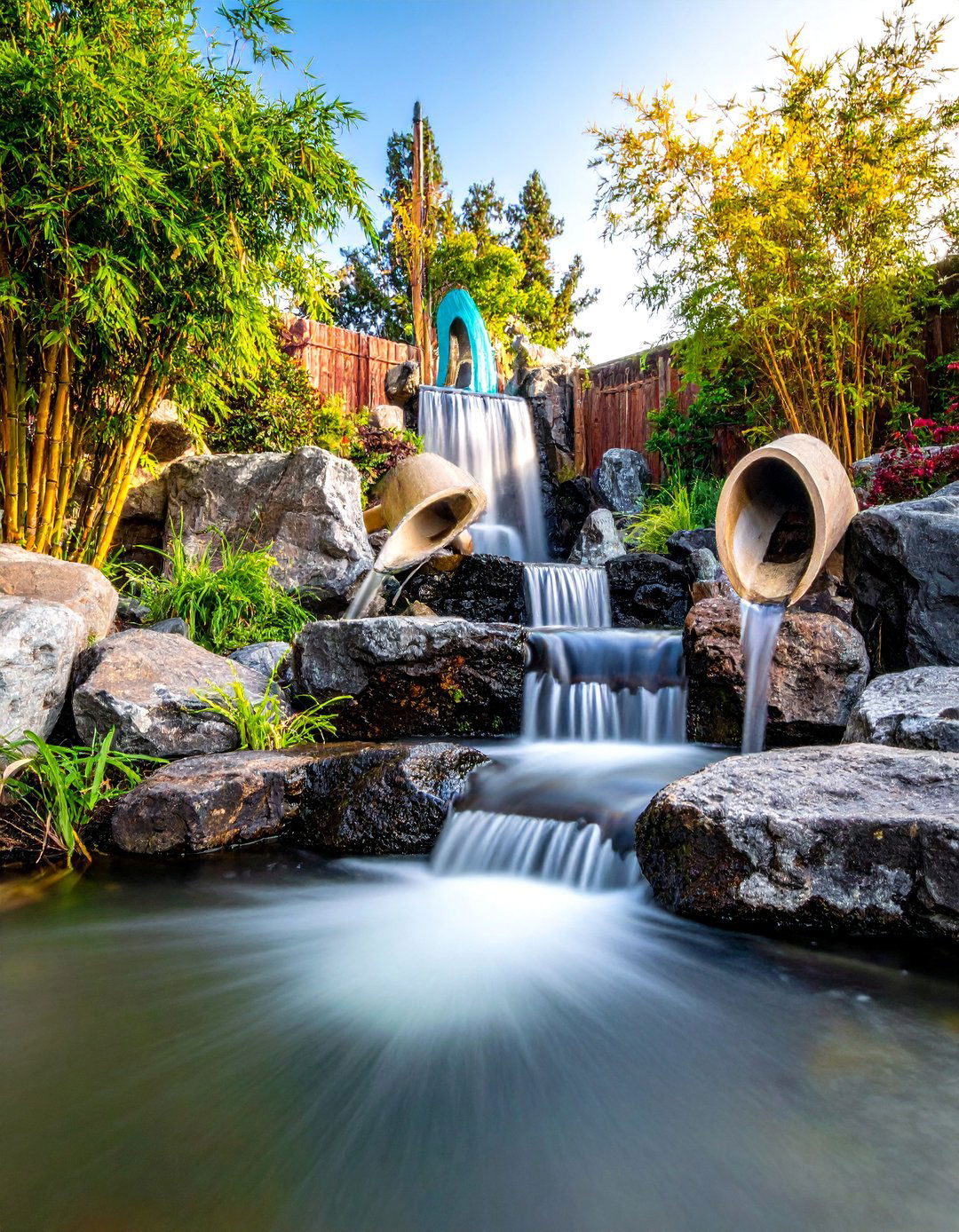
What ancient design principles can bring tranquility and mindfulness to modern outdoor spaces? Japanese-inspired bamboo waterfalls incorporate traditional elements like bamboo spouts and carefully arranged stones to create serene meditation spaces. Water flows through hollow bamboo sections that direct gentle streams into stone basins below, creating soft, rhythmic sounds that promote relaxation and contemplation. The design emphasizes simplicity and natural materials, with each element carefully chosen and positioned according to traditional Japanese aesthetic principles. Surrounding plantings typically include species common in Japanese gardens such as hostas, ferns, and small maples that provide subtle seasonal changes. The feature often incorporates traditional elements like stone lanterns or small bridges that enhance the cultural authenticity. Maintenance involves regular cleaning of bamboo elements and seasonal replacement as needed, but the simple design makes upkeep manageable. The resulting atmosphere encourages mindful appreciation of nature's subtle beauty, making these features perfect for creating private retreat spaces where daily stress dissolves into peaceful contemplation of flowing water and natural harmony.
11. Mediterranean Terracotta Waterfall
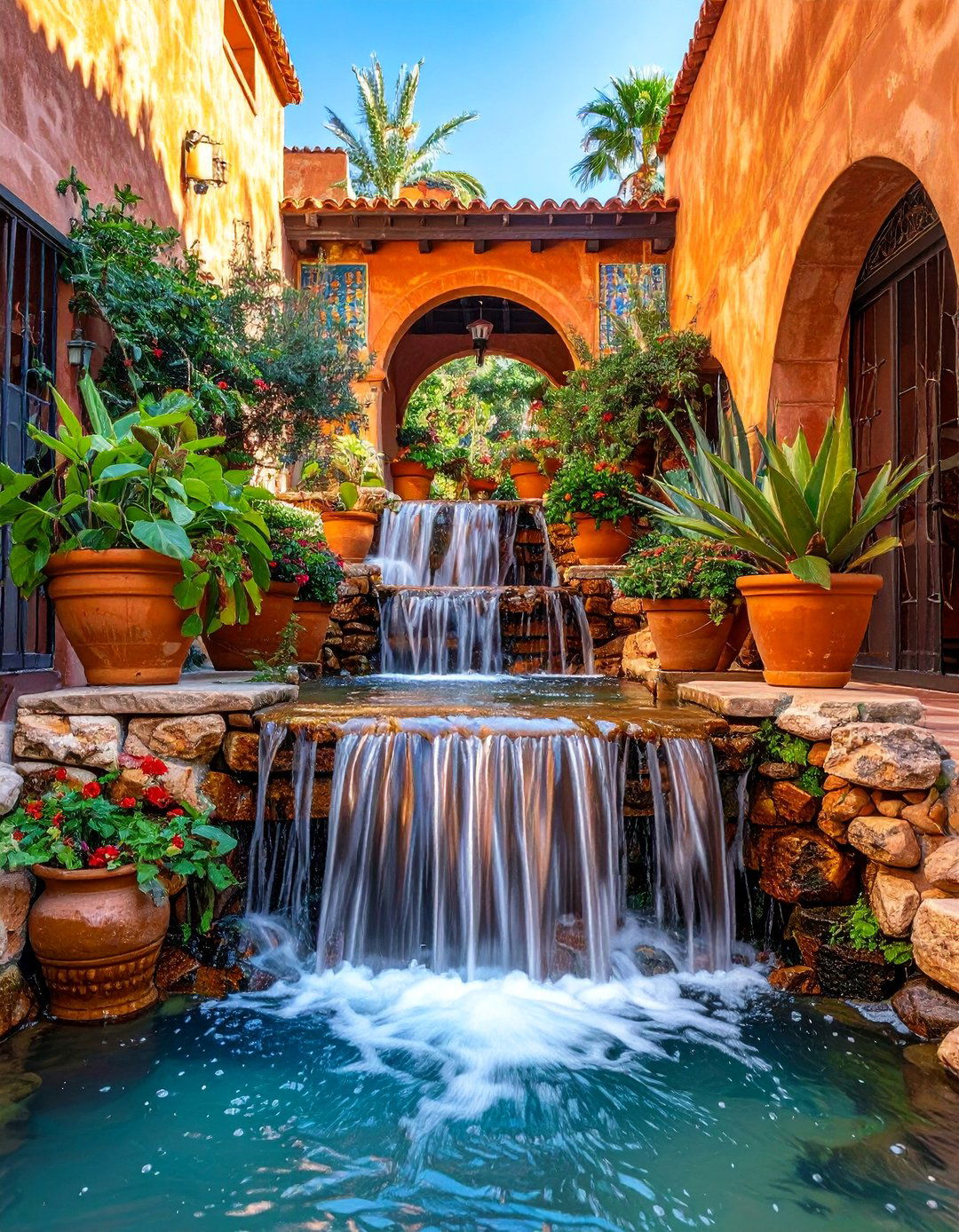
How can warm, earthy materials evoke the romance of Mediterranean landscapes? Mediterranean terracotta waterfalls use warm-colored clay vessels and tiles to create water features reminiscent of Italian or Spanish courtyards. Large terracotta pots, urns, and decorative tiles in warm orange, amber, and cream tones create inviting displays that complement Mediterranean-style homes and gardens. Water flows from vessel to vessel or over decorative tile surfaces, creating gentle sounds that enhance the relaxed atmosphere associated with Mediterranean living. The features often incorporate herbs like rosemary, lavender, and thyme that release pleasant fragrances when warmed by sun or brushed by visitors. Decorative elements like hand-painted tiles or glazed pottery add artistic touches that reflect traditional craftsmanship. The warm colors and natural materials create inviting spaces perfect for outdoor dining or casual entertaining. Evening lighting emphasizes the warm tones and creates intimate atmospheres ideal for wine tastings or dinner parties. These features bring vacation-like ambiance to everyday outdoor living, transforming ordinary patios into romantic retreats inspired by Mediterranean coastal living.
12. Minimalist Steel Waterfall Design
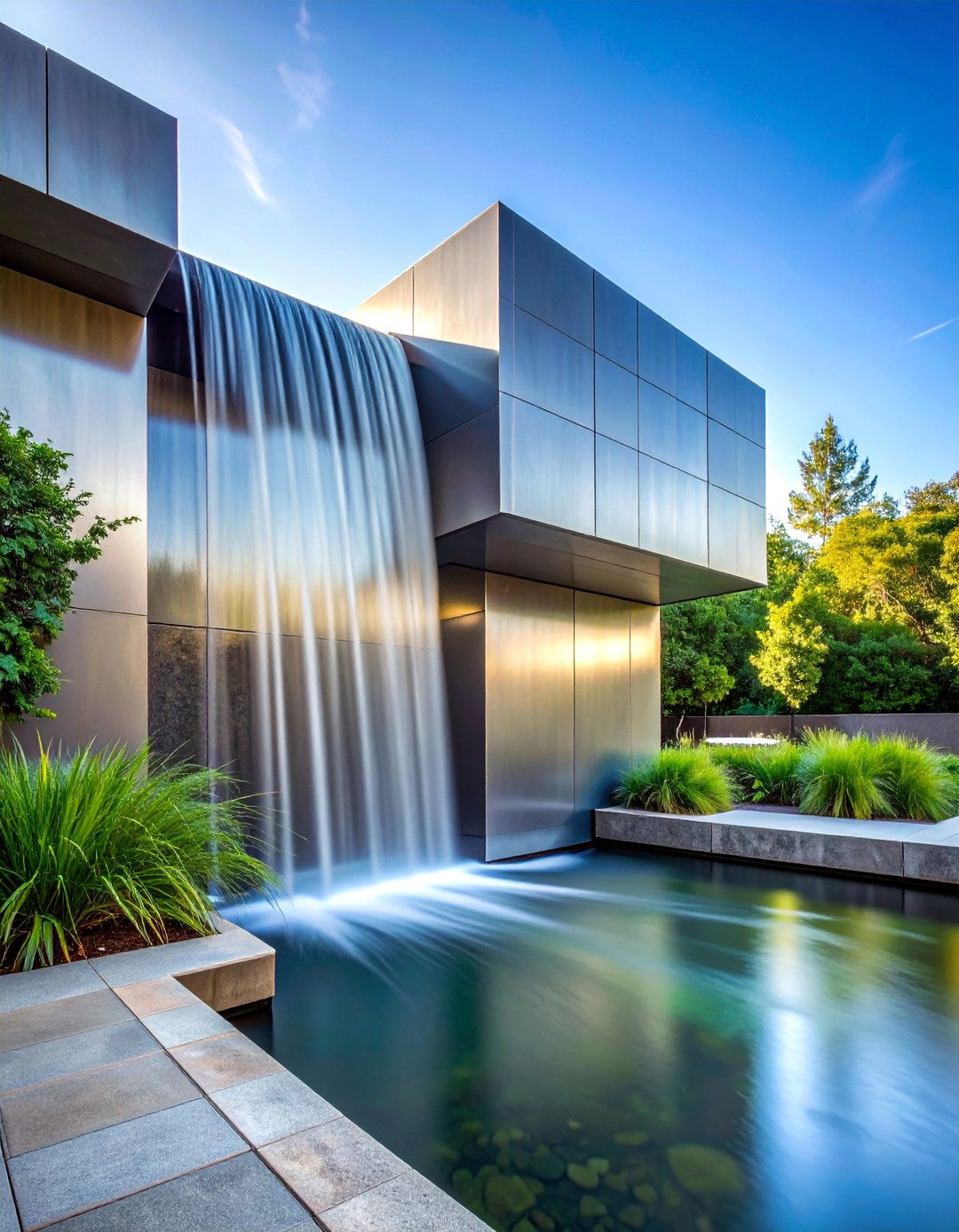
What happens when industrial materials meet water in pursuit of ultimate simplicity? Minimalist steel waterfall designs use clean metal surfaces and geometric forms to create sophisticated water features that emphasize form over ornamentation. Stainless steel or weathering steel panels create perfectly smooth water surfaces that flow in controlled sheets, emphasizing the purity of water movement without distracting elements. The metal surfaces develop attractive patinas over time, particularly with weathering steel that creates rich rust colors that complement natural surroundings. These designs often feature single, dramatic water sources that create focal points through their bold simplicity rather than complex arrangements. The underground reservoir system typically uses matching metal elements or neutral materials like dark gravel that don't compete with the feature's stark beauty. Surrounding plantings emphasize architectural plants with strong forms that echo the geometric nature of the metal elements. The result creates outdoor spaces with gallery-like qualities where water becomes sculptural art, appealing to homeowners who appreciate contemporary design and the beauty found in essential forms stripped of unnecessary complexity.
13. Cottage Garden Trickling Stream
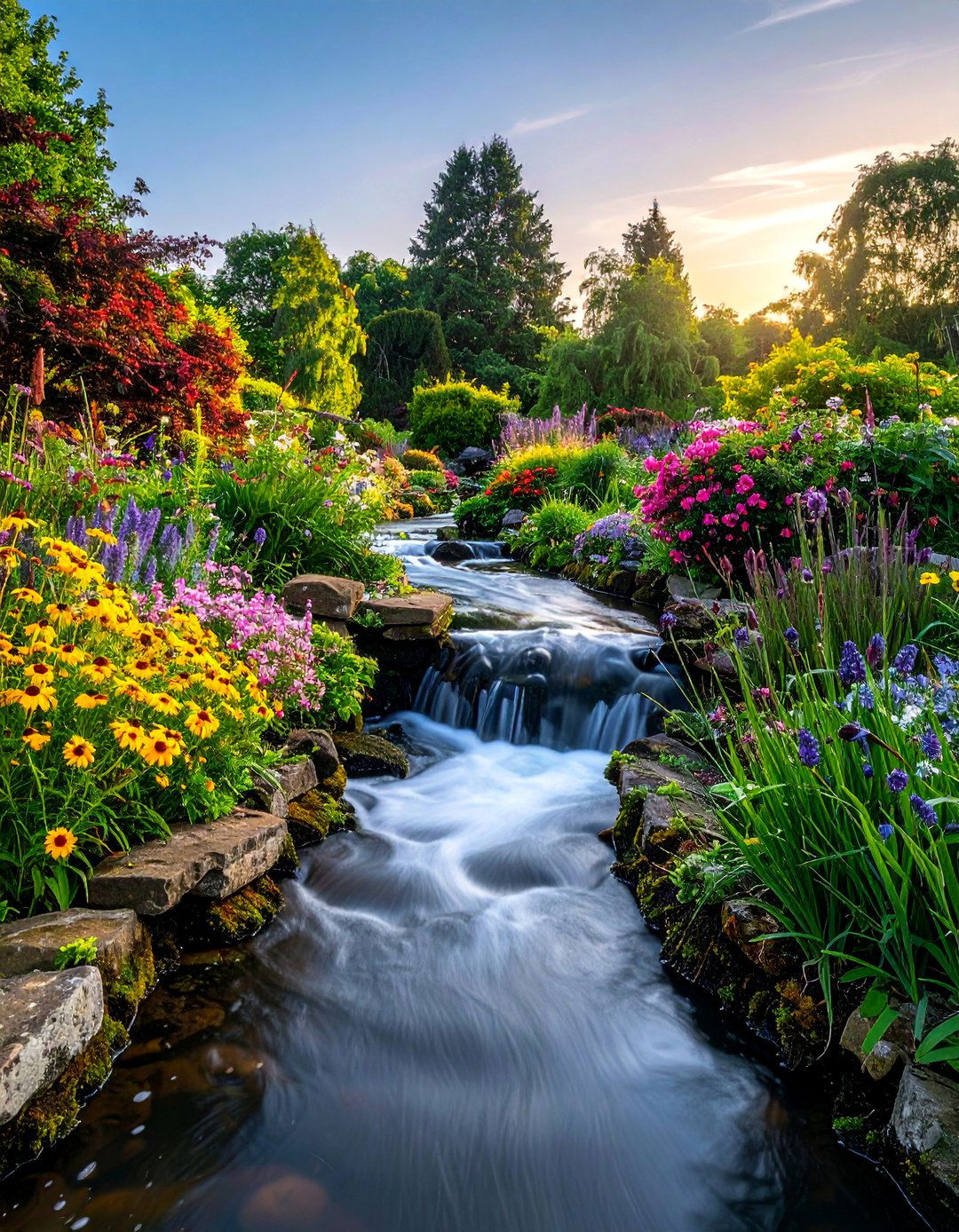
Could informal plantings and gentle water create charming English countryside atmosphere? Cottage garden trickling streams wind through lush, informal plantings to create romantic water features that celebrate abundant natural growth. Small streams meander between flowering perennials, herbs, and cottage garden favorites like roses, delphiniums, and hollyhocks that create colorful, fragrant displays throughout growing seasons. The water movement is gentle and subtle, creating soft background sounds that complement rather than compete with garden bird songs and buzzing insects. Natural materials like weathered stone and aged timber are used for stream edges and small bridges that allow garden exploration without disturbing planted areas. The informal style encourages plants to self-seed and spread naturally, creating the slightly overgrown appearance that characterizes authentic cottage gardens. Seasonal bulbs provide spring color, while late-blooming perennials extend interest into autumn months. The overall effect creates gardens that feel like they've evolved naturally over many years, providing perfect settings for morning coffee or afternoon tea surrounded by the sights, sounds, and fragrances of traditional English countryside.
14. LED Color-Changing Waterfall Display
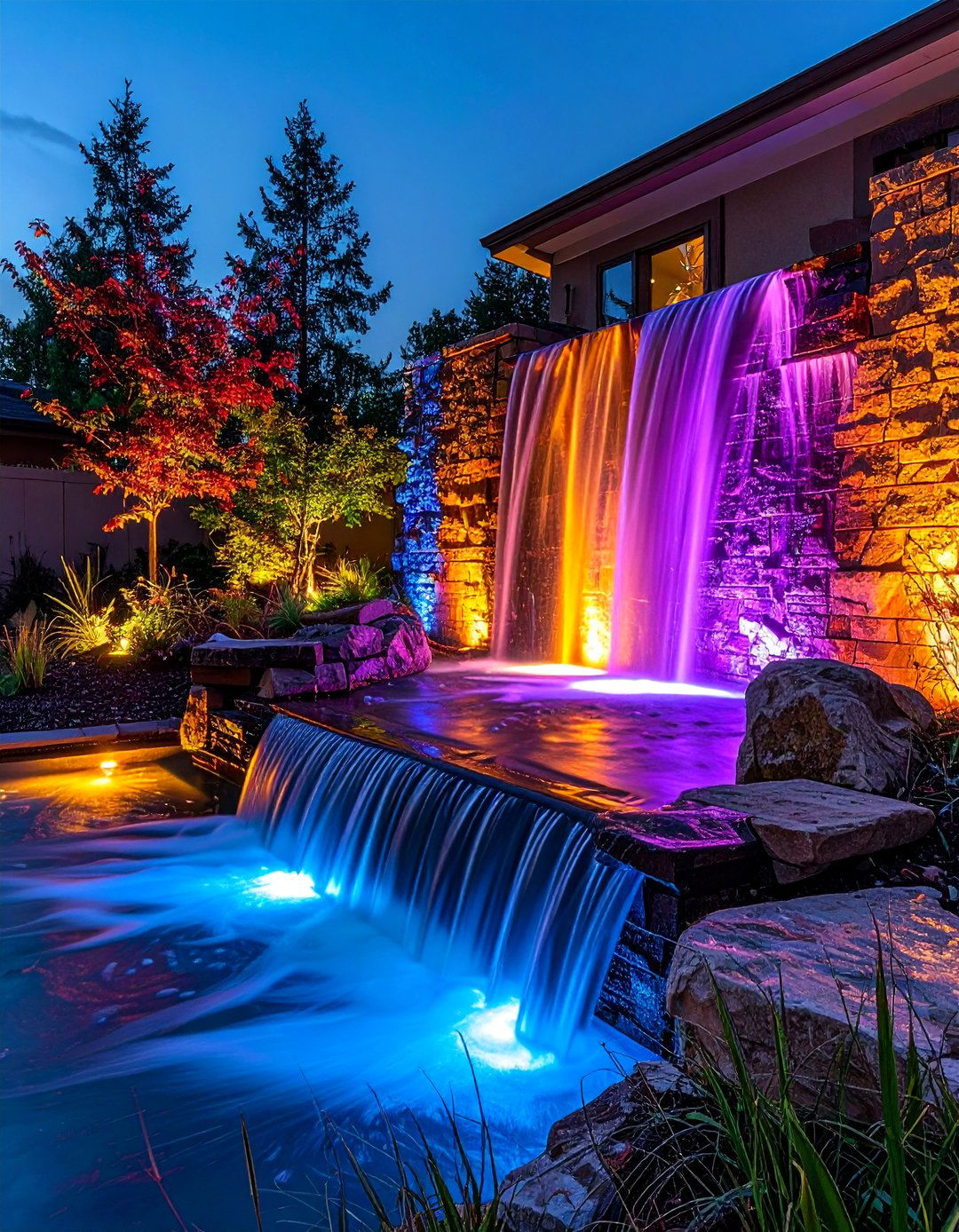
How can modern lighting technology transform water features into dynamic art installations? LED color-changing waterfall displays use programmable lighting systems to create water features that adapt their appearance throughout the day and seasons. Advanced LED systems can produce thousands of color combinations that can be programmed to change gradually or respond to music, creating entertainment value beyond traditional water features. The lights can be positioned underwater, behind flowing water, or integrated into surrounding landscape elements to create coordinated lighting effects. Smart control systems allow homeowners to adjust colors and patterns using smartphone apps, making it easy to create appropriate atmospheres for different occasions or seasons. Holiday themes become possible with red and green for Christmas or orange and purple for Halloween, while subtle color changes can enhance evening entertaining or romantic occasions. The energy-efficient LED technology ensures minimal operating costs while providing maximum visual impact. These features appeal particularly to tech-savvy homeowners who enjoy customizable outdoor environments and the ability to create unique experiences for family gatherings and entertaining guests with memorable, ever-changing displays.
15. Herb Garden Waterfall Integration
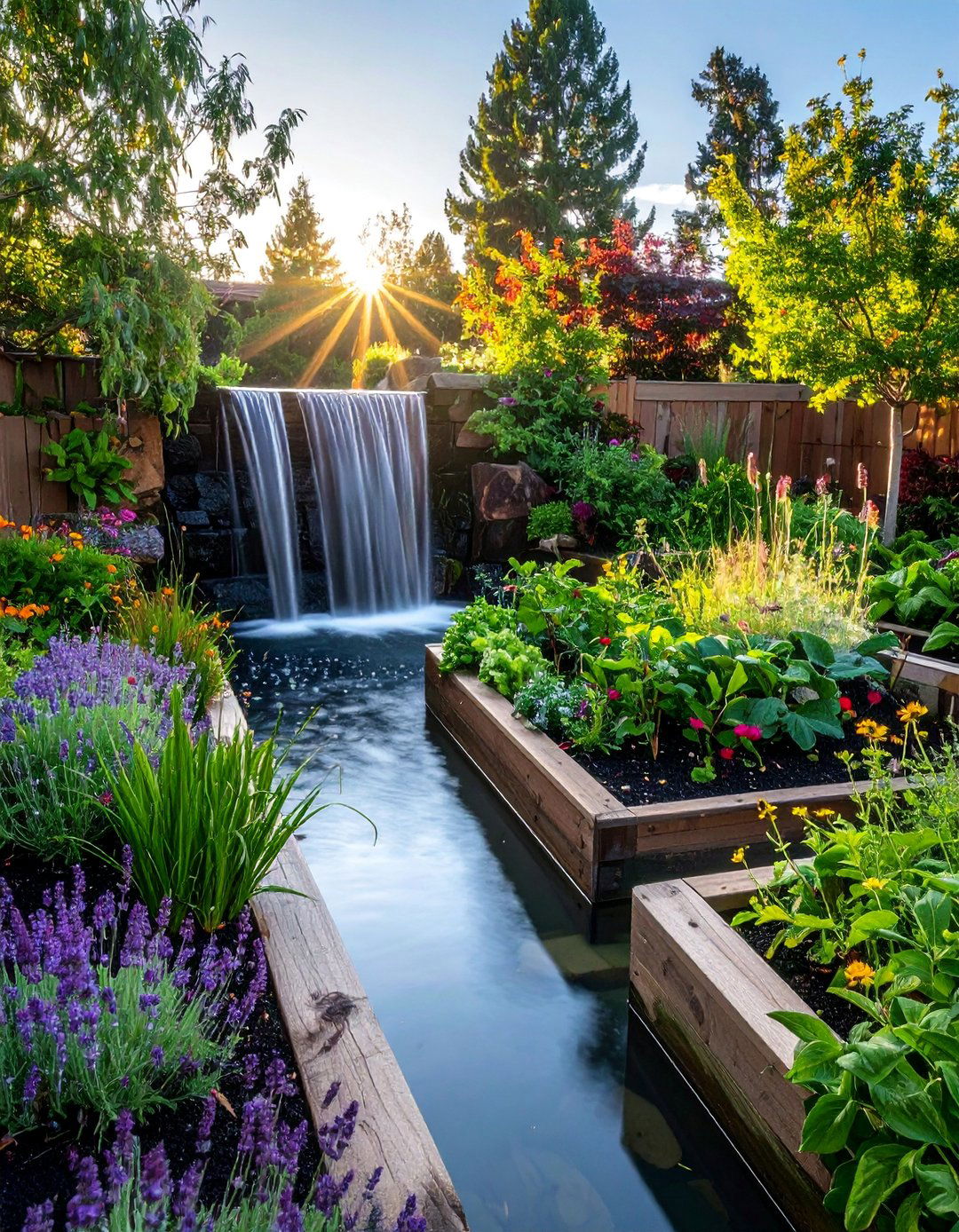
Why not combine practical gardening with beautiful water features for double enjoyment? Herb garden waterfall integrations create functional landscapes where flowing water nourishes culinary plants while providing beautiful focal points for outdoor kitchens and dining areas. Water flows through or near planted areas containing herbs like mint, parsley, chives, and watercress that benefit from consistent moisture and enhanced humidity. The design often incorporates raised planting beds or terraced areas where different herbs can be organized according to their water and sun requirements. Edible flowers like nasturtiums and calendulas add seasonal color while providing ingredients for creative cooking and garnishing. The proximity to water creates microclimates that extend growing seasons and support herbs that might struggle in drier locations. Practical elements like harvest baskets and tool storage can be integrated into the design for convenient garden maintenance. Evening lighting enhances both the water features and plant displays, creating inviting spaces for outdoor dining where fresh herbs are literally within arm's reach. These features appeal to homeowners who value self-sufficiency and enjoy connecting food production with landscape beauty, creating productive gardens that nourish both body and spirit.
Conclusion:
Pondless waterfalls represent the perfect marriage of beauty and practicality in modern landscape design. These versatile features adapt to any space, style, or budget while providing years of low-maintenance enjoyment. From natural rock cascades that mimic mountain streams to contemporary steel designs that serve as outdoor art installations, pondless waterfalls offer endless possibilities for creating personalized outdoor retreats. The safety benefits make them ideal for families, while the minimal maintenance requirements appeal to busy homeowners who want beautiful landscapes without constant upkeep. Whether you choose dramatic multi-tier boulder arrangements, romantic cottage garden streams, or high-tech LED color-changing displays, your pondless waterfall will become a cherished focal point that enhances property value while providing daily tranquility. The sound of flowing water, combined with the visual appeal of your chosen design, creates outdoor spaces that invite relaxation and connection with nature, transforming ordinary yards into extraordinary personal sanctuaries.

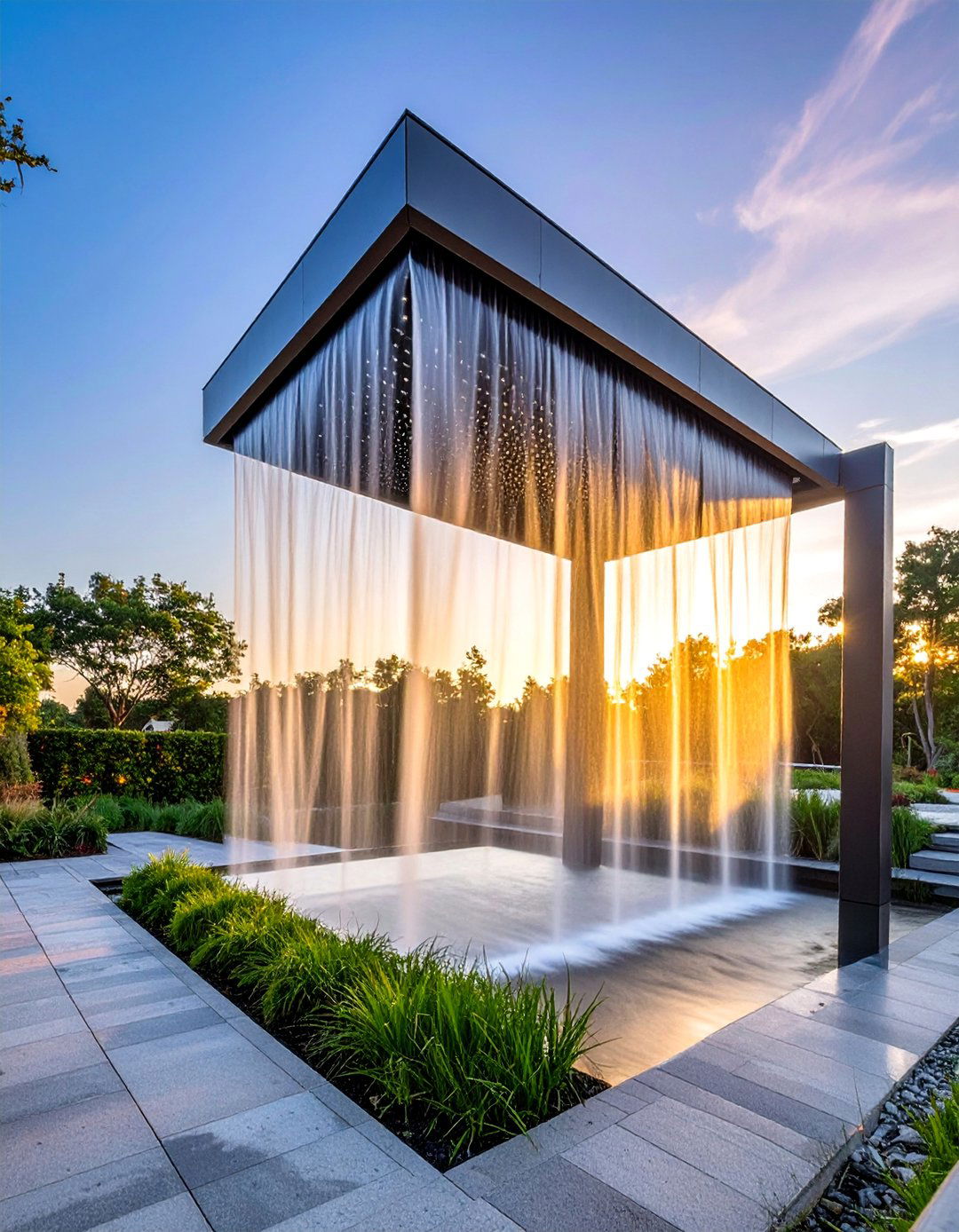
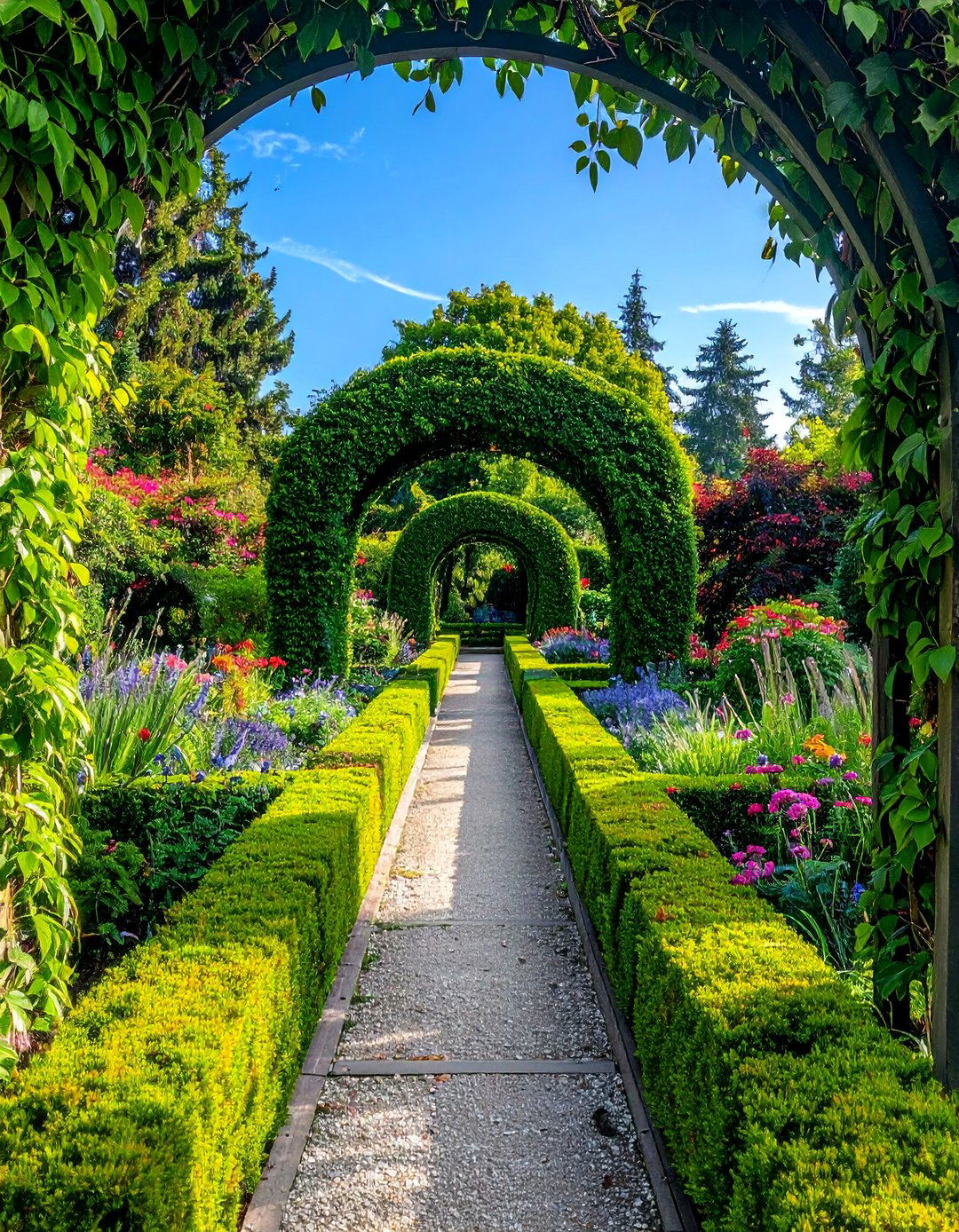
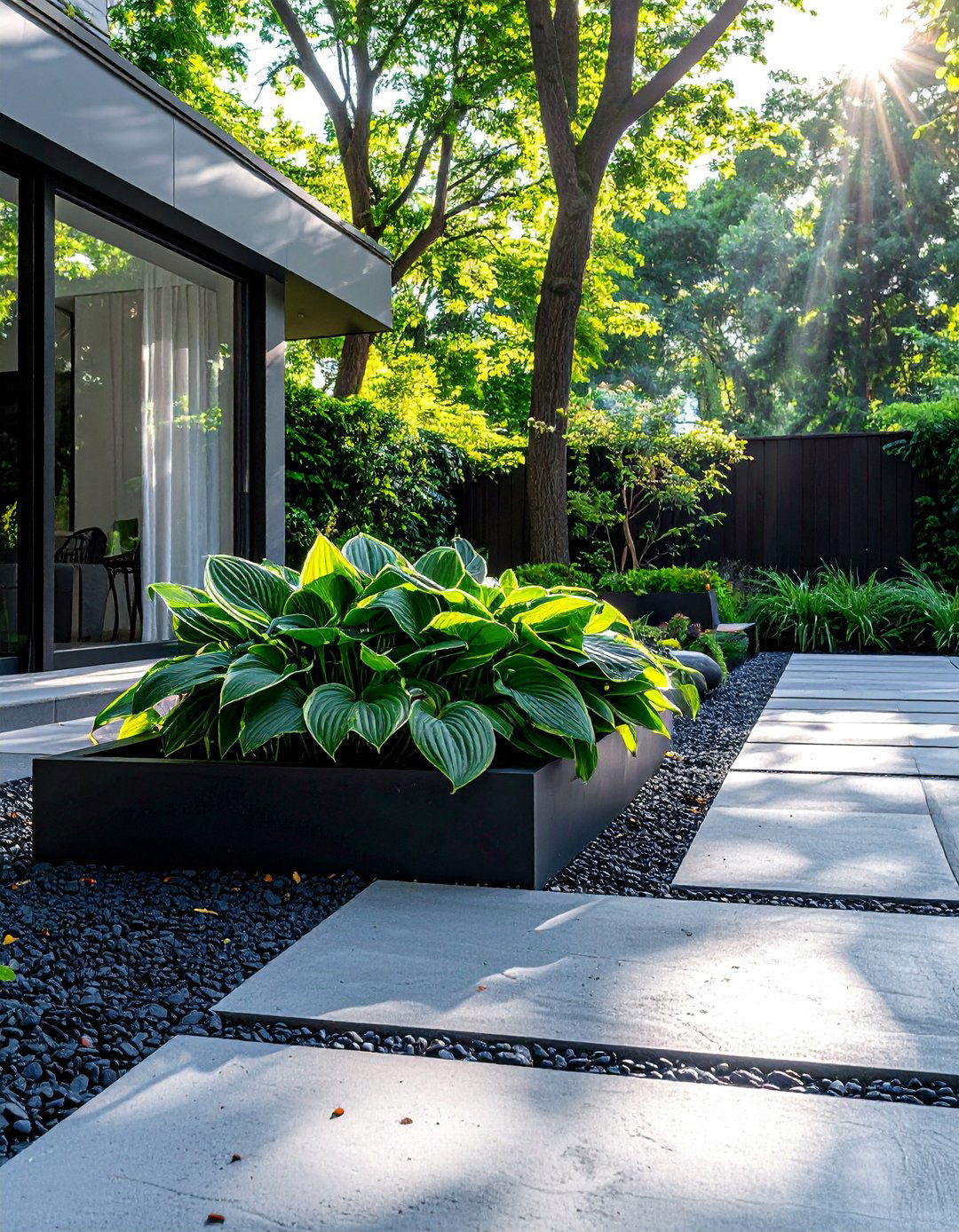
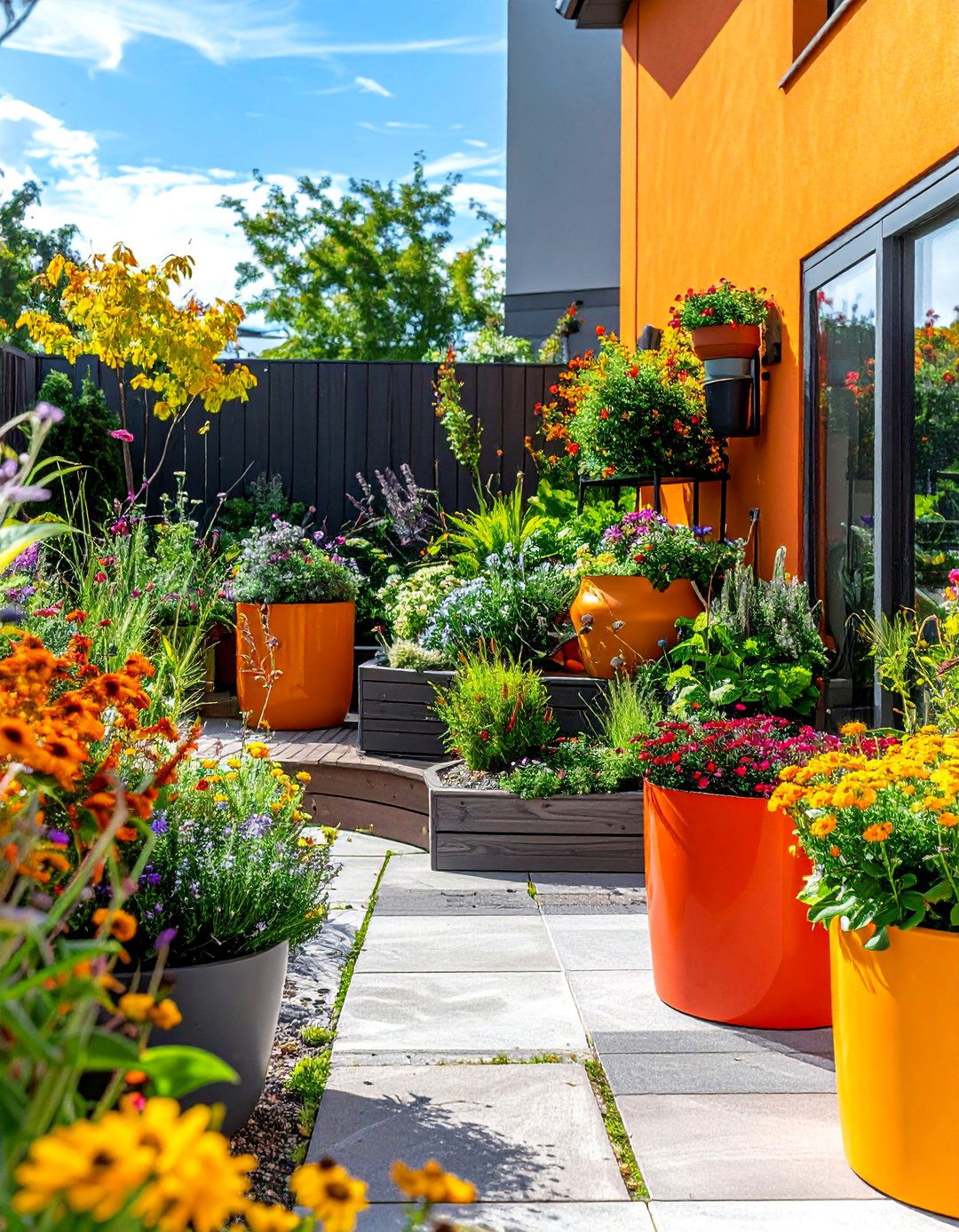
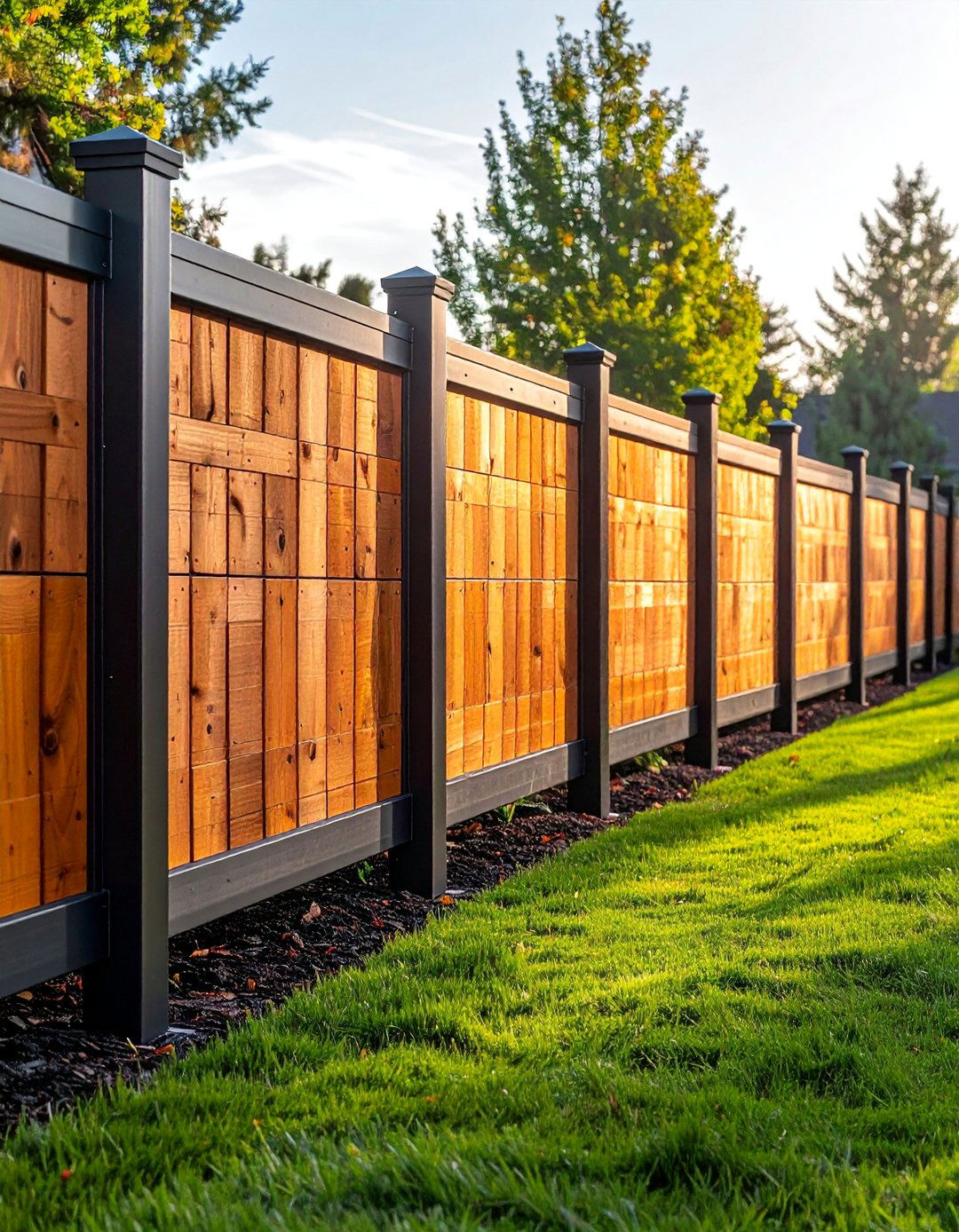
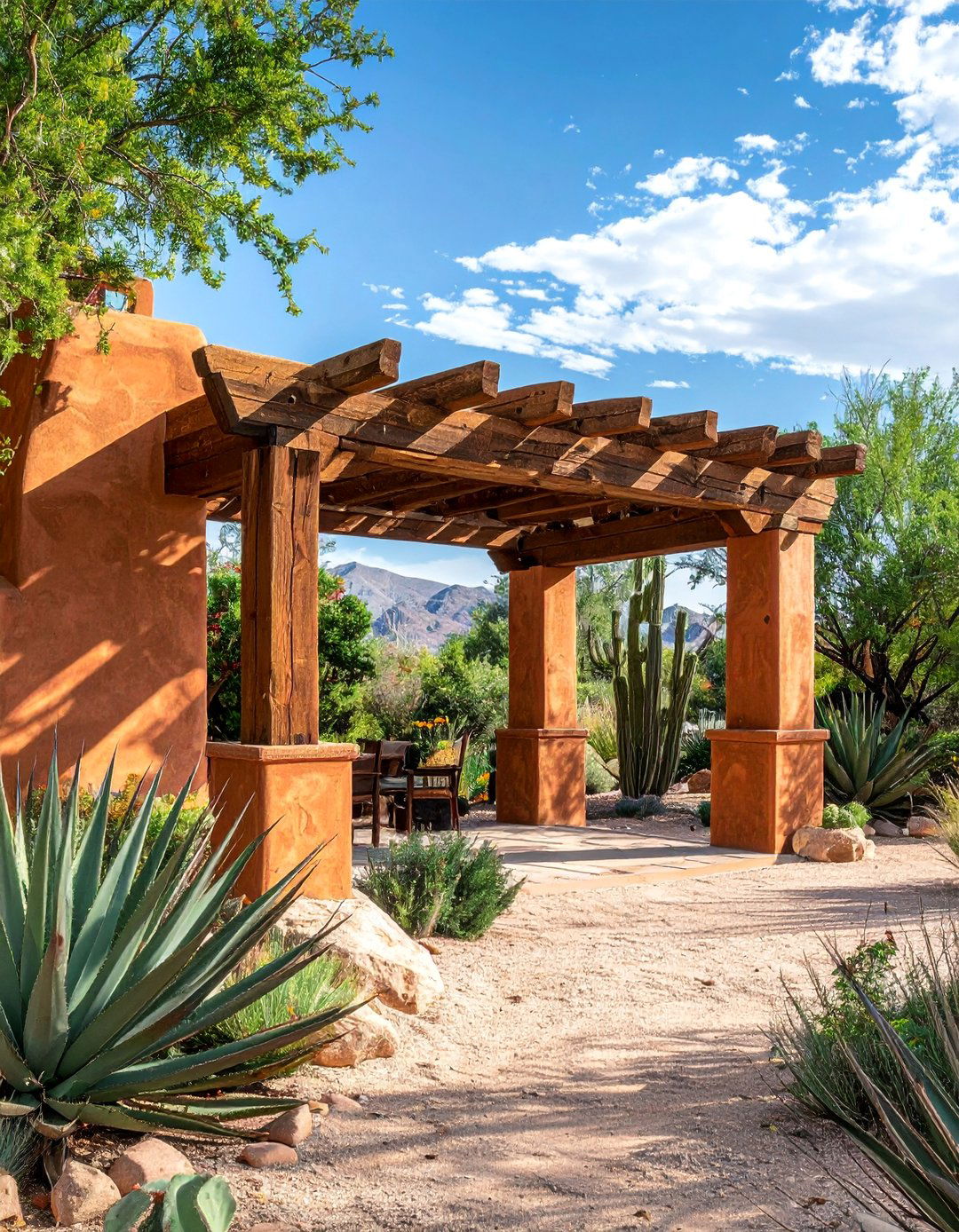
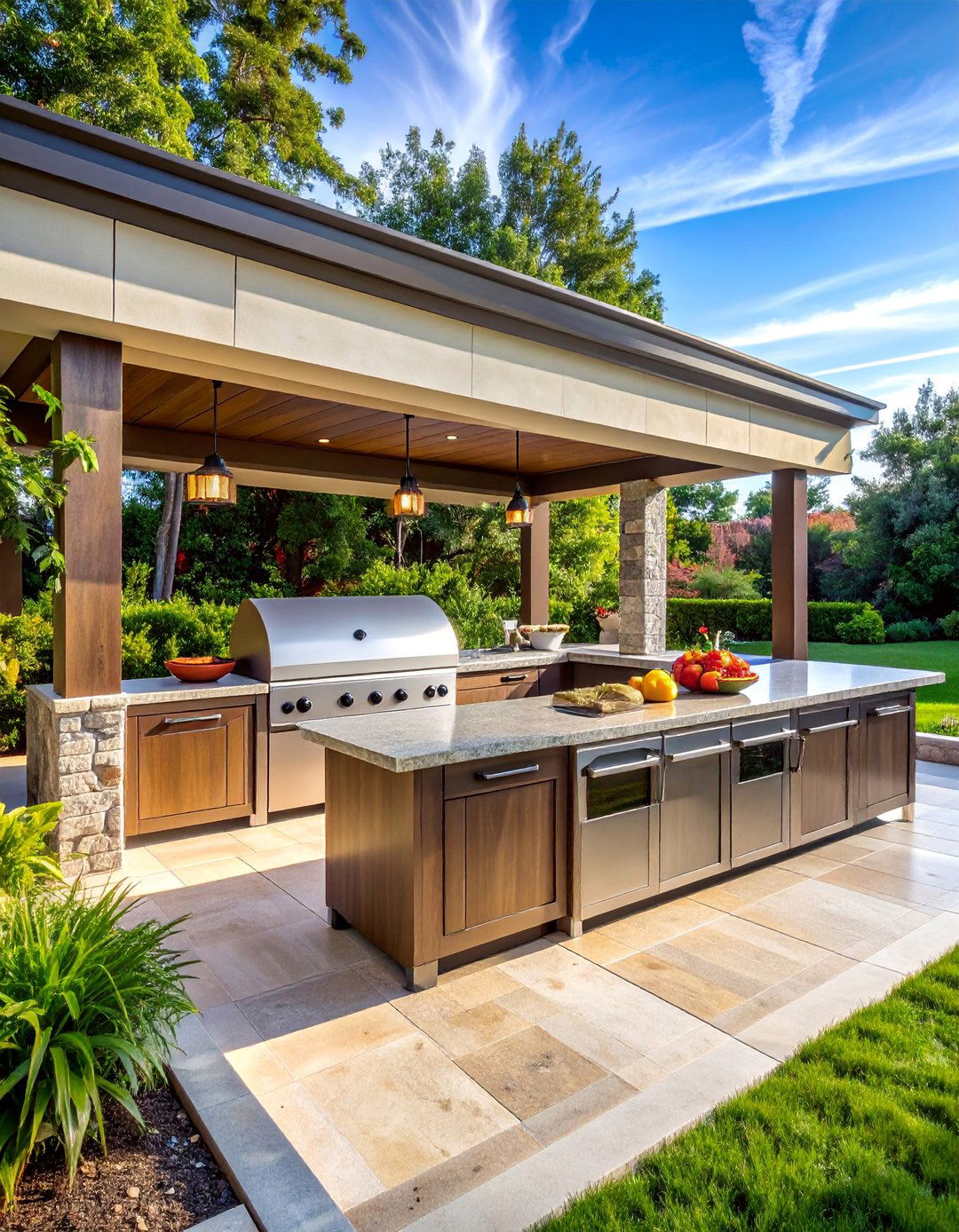
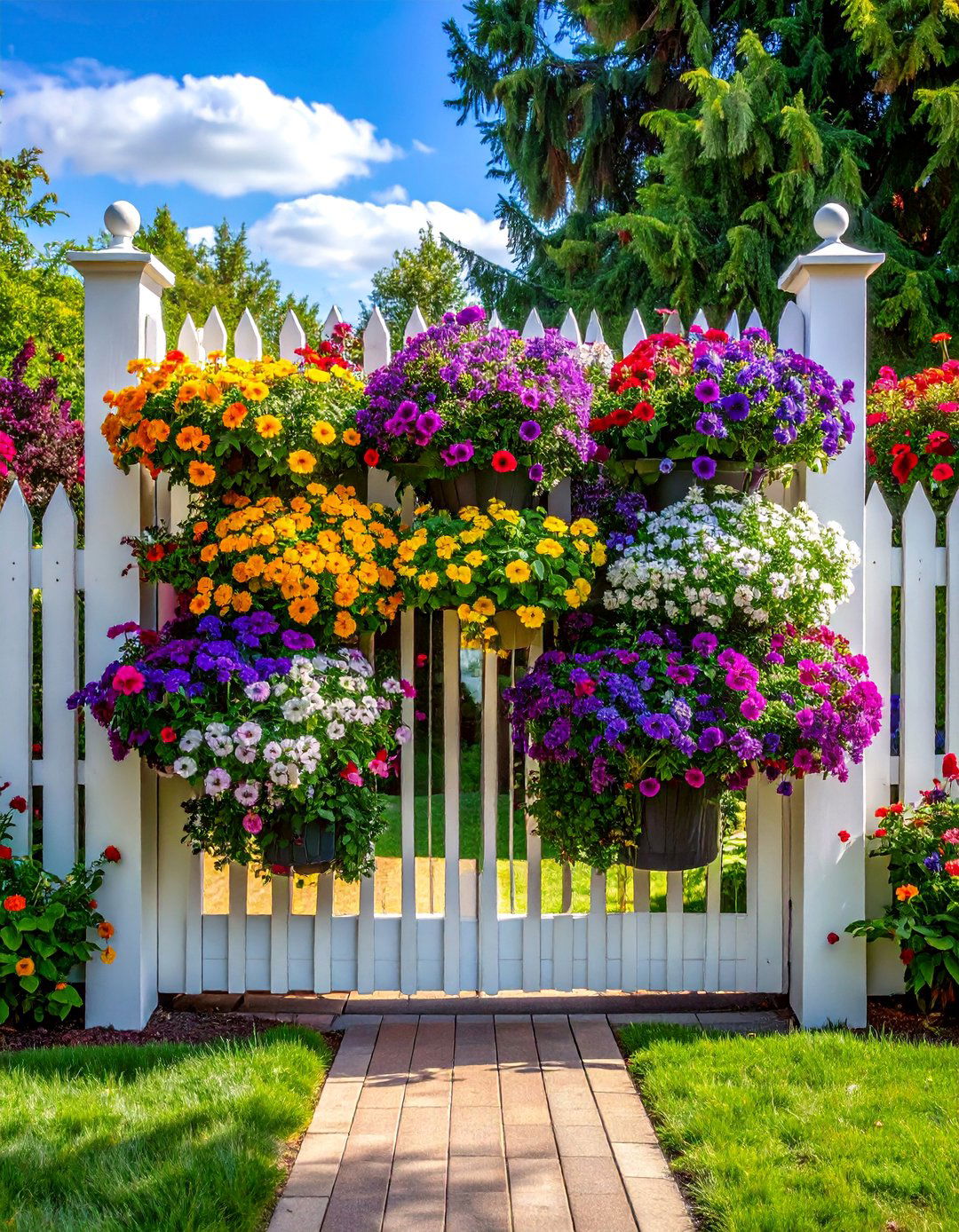
Leave a Reply